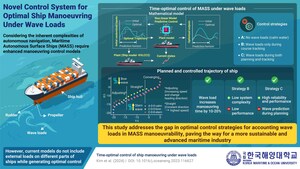KMOU Scientist Highlight Limitations in the Design Guidelines for Liquid Cargo Tanks
Current methodologies misrepresent the sloshing phenomenon, which is critical in the maritime transport of liquid hydrogen and liquefied natural gas.
BUSAN, South Korea, Nov. 24, 2023 /PRNewswire/ -- Many countries around the world are starting to gravitate towards clean energy sources and more eco-friendly fuels, such as hydrogen and natural gas. When transported overseas by cargo ships, these fuels are maintained in their liquid state within large tanks. Carrying them as liquids is not only safer but also more efficient in terms of energy and space. However, there is an important phenomenon that ship designers and engineers should never ignore: sloshing.
When a tank carrying a liquid is only partially filled, changes in the speed and direction of the ship cause the liquid to move back and forth, much like coffee does when the cup holding it is moved suddenly. This sloshing motion can exert great pressure on the tank's structure and create large weight shifts, which can lead to toppling. To prevent such problems, national and international maritime organizations have provided guidelines known as "classification rules," which provide methods for calculating sloshing loads based on a series of design parameters.
However, according to a recent study conducted by researchers from Korea, these guidelines may be suffering from some serious limitations. By leveraging advanced fluid dynamics simulations, Assistant Professor Hyun-Duk Seo from Korea Maritime and Ocean University and Dr. Jae-Min Lee from Chonnam National University have investigated whether the parameters considered in classification rules adequately represent the sloshing phenomenon. Their study was made available online on July 17, 2023, and published in a Special Collection of the journal Physics of Fluids on Recent Advances in Marine Hydrodynamics.
The researchers employed a technique known as smoothed particle hydrodynamics, which represents a fluid as a collection of individual particles. Using this method, they conducted several simulations involving different tank sizes, loads, and bulkheads—internal walls with holes used to create partitions inside tanks, which helps minimize sloshing.
Interestingly, the simulations revealed many aspects of sloshing that the design parameters specified in classification rules failed to represent accurately. Notably, bulkheads having different hole geometries but yielding the same parameter values resulted in considerably different liquid surface profiles, pressure distributions, and fluid velocities. "Based on the obtained results, it is evident that the classification rules do not consider the impact of the design parameters in sufficient detail," highlights Dr. Seo. "Therefore, it is necessary to revise these guidelines so that they address these limitations and ensure the reliable design of liquid cargo tanks."
Further work will be needed to incorporate these newfound insights into current design methodologies for liquid cargo tanks. This, in turn, would not only help prevent catastrophic accidents but would also lead to optimal tank designs to make maritime transport cheaper. Dr. Seo highlights: "Our research will pave the way to a better understanding of existing classification rules and their limitations. Ultimately, we aim to contribute to the development of cost-effective and safe technologies for transporting essential energy resources used in daily life."
With any luck, this study will serve as a major step towards efficient fuel transportation and a more sustainable future!
Reference
Title of original paper: Investigation of design parameters related to sloshing loads using smoothed particle hydrodynamics and rule-based estimations
Journal: Physics of Fluids
DOI: https://doi.org/10.1063/5.0156550
About National Korea Maritime & Ocean University
Website: http://www.kmou.ac.kr/english/main.do
Contact:
Hong Jun Cho
+82 51 410 5147
369043@email4pr.com
SOURCE National Korea Maritime & Ocean University

WANT YOUR COMPANY'S NEWS FEATURED ON PRNEWSWIRE.COM?
Newsrooms &
Influencers
Digital Media
Outlets
Journalists
Opted In





Share this article